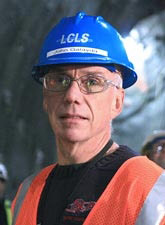
Handy Links
SLAC News Center
SLAC Today
- Subscribe
- Archives: Feb 2006-May 20, 2011
- Archives: May 23, 2011 and later
- Submit Feedback or Story Ideas
- About SLAC Today
SLAC News
Lab News
- Interactions
- Lightsources.org
- ILC NewsLine
- Int'l Science Grid This Week
- Fermilab Today
- Berkeley Lab News
- @brookhaven TODAY
- DOE Pulse
- CERN Courier
- DESY inForm
- US / LHC
SLAC Links
- Emergency
- Safety
- Policy Repository
- Site Entry Form

- Site Maps
- M & O Review
- Computing Status & Calendar
- SLAC Colloquium
- SLACspeak
- SLACspace
- SLAC Logo
- Café Menu
- Flea Market
- Web E-mail
- Marguerite Shuttle
- Discount Commuter Passes
-
Award Reporting Form
- SPIRES
- SciDoc
- Activity Groups
- Library
Stanford
Around the Bay
From the Director of LCLS Construction:
Okay, So We Build the LCLS
and Turn It On—Then What?

Holding down the cost was considered important to keeping the LCLS proposal viable; every effort was made to re-use existing facilities. In 1996, the design made use of the Final Focus Test Beam facility to house the undulator magnets. A 24-meter long enclosure built onto the end of the Final Focus Test Beam (FFTB) was provided for x-ray experiments. The need for longer x-ray beamlines was recognized back then, and the 1996 Design Study Report included a concept for shooting LCLS x-rays to the eastern edge of the SLAC site through a very narrow tunnel.
By 1995, however, the scientific potential for an x-ray free-electron laser was getting widespread recognition. The German physics lab DESY proposed a huge FEL facility attached to the TESLA linear collider at the 1996 Future Light Sources workshop in Grenoble, France. It became possible to "think big" about FELs. An expansion of the LCLS concept, to a bundle of four undulator x-ray sources, was written up in 2000.
I arrived at SLAC in 2001. By this time the LCLS design had grown. What had been proposed as a single experiment in the Research Yard had become a large building capable of holding four experiment enclosures, and was called the "Near Hall." A "Far Experiment Hall" was located about where the real Near Experiment Hall is located today. In 2002, the Department of Energy (DOE) gave LCLS "Critical Decision 1" approval, thereby accepting the LCLS Conceptual Design. I had the opportunity to meet Ray Orbach, Director of the Office of Science, in September 2002, just before he signed off on CD-1. He asked me pointed questions about the LCLS: Was the design limited in some way? Was it a good long-term investment for the DOE? He made it very clear that he would be satisfied with nothing less than a FEL facility that would be the most advanced in the world—not just when it turned on, but for decades to come and when new competing facilities came on-line. His "criticisms" were music to my ears!
I brought the message back to SLAC. The LCLS team got to work. With the enthusiastic support of Jonathan Dorfan and Keith Hodgson, we changed the layout of the LCLS facility to allow expansion to six or more "hard" x-ray FELs. This is the layout which is now being constructed. There is room in the LCLS tunnel for the second of these six undulator sources. The Near Experiment Hall is where the Far Experiment Hall used to be, and the Far Experiment Hall is the underground vault you saw in SLAC Today on Tuesday. The cost of the LCLS went up, but the DOE encouraged the new design as it developed in 2003–2004. We were off and running. The LCLS team and Stanford Synchrotron Radiation Laboratory (SSRL) researchers have published enough forefront ideas for new free-electron laser sources to keep us busy for another 20 years or more. There are concepts for expanding the LCLS beyond the earlier six-undulator layout. The DOE is fully aware of SLAC’s desire to start constructing a second undulator source in the existing LCLS tunnel. The ball is in our court; we must decide which of the many options for the second undulator we should propose.
The SLAC linac, the centerpiece of its high-energy physics program since the construction of the lab, was the enabling asset that made it possible to hold down the price of the original LCLS concept. It turns out that the linac ensures that SLAC is capable of hosting the most advanced x-ray FELs that anyone has envisioned to date. The maximum energy of the SLAC linac, 50 GeV, is believed to be about the highest energy beam that one can possibly use to make an FEL work. As of today, we think that a strong case can be made for a world-leading FEL using a 30 GeV beam and there is no FEL proposal in the world that envisions so high an energy. Because of this energy reach, we have an inherent advantage in peak intensity at wavelengths from 50 Angstroms to 1 Angstrom—the size of an atom—and shorter. This gives us the ability to image very dense materials on ultra-small size scales to a degree impossible anywhere else. The DOE was impressed with the preview of these capabilities presented to them recently by SLAC Director Persis Drell.
When it turns on, the LCLS faces a very bright future as the world's top light source. I feel confident that we have met Ray Orbach’s challenge. The LCLS will not be "merely" the world's first "hard" x-ray FEL. SLAC is equipped to lead the world in this research area for years to come.
—John Galayda, SLAC Today, January 18, 2008